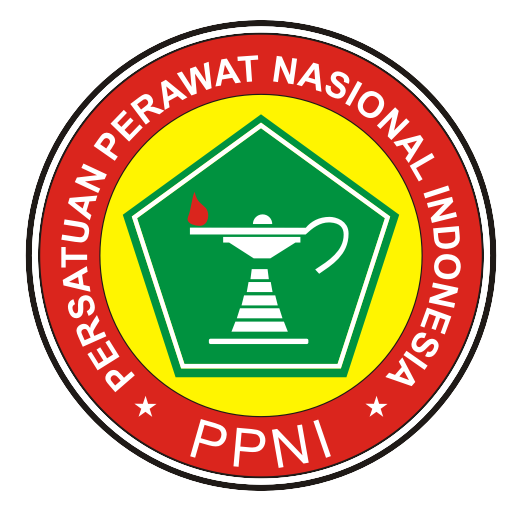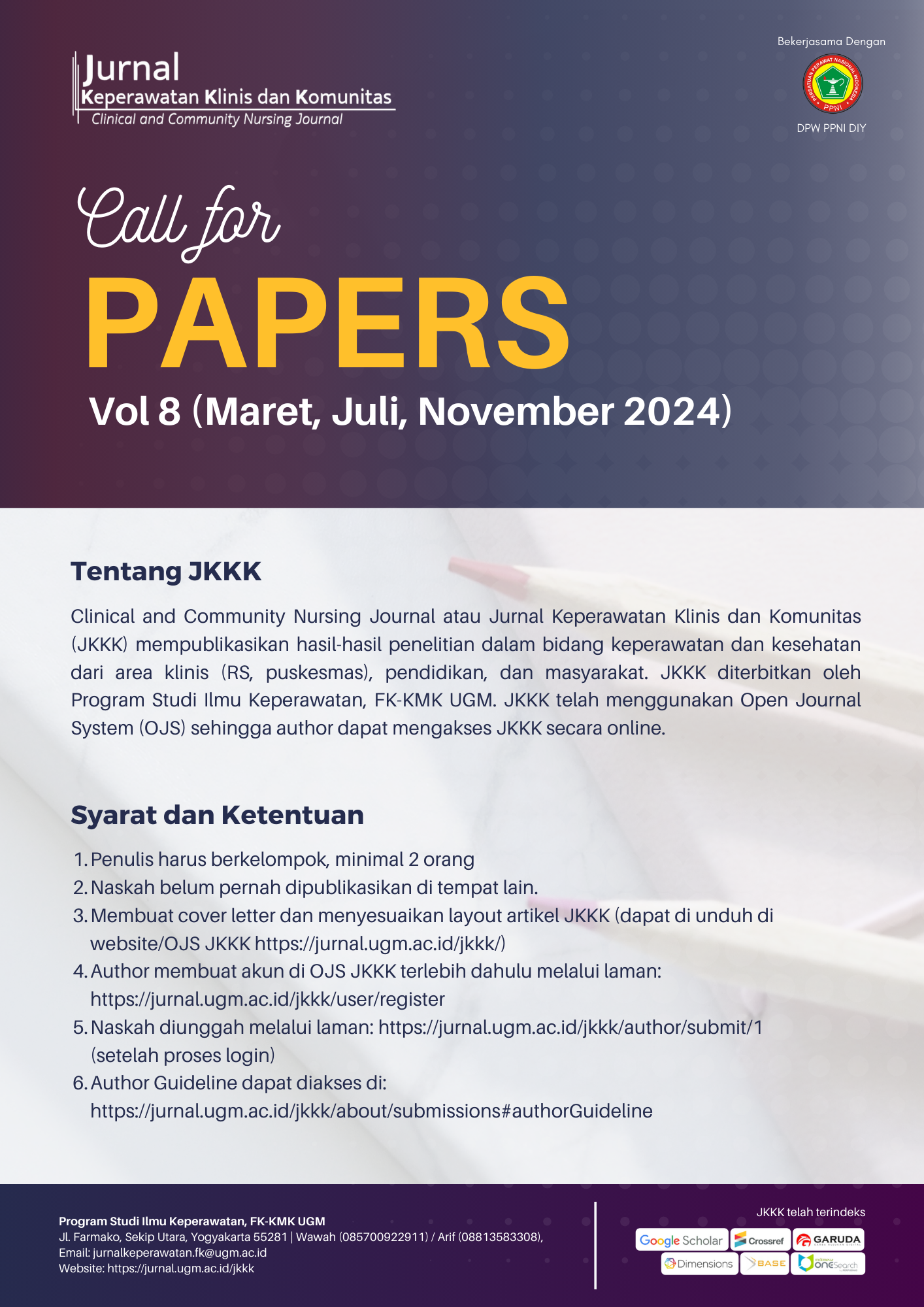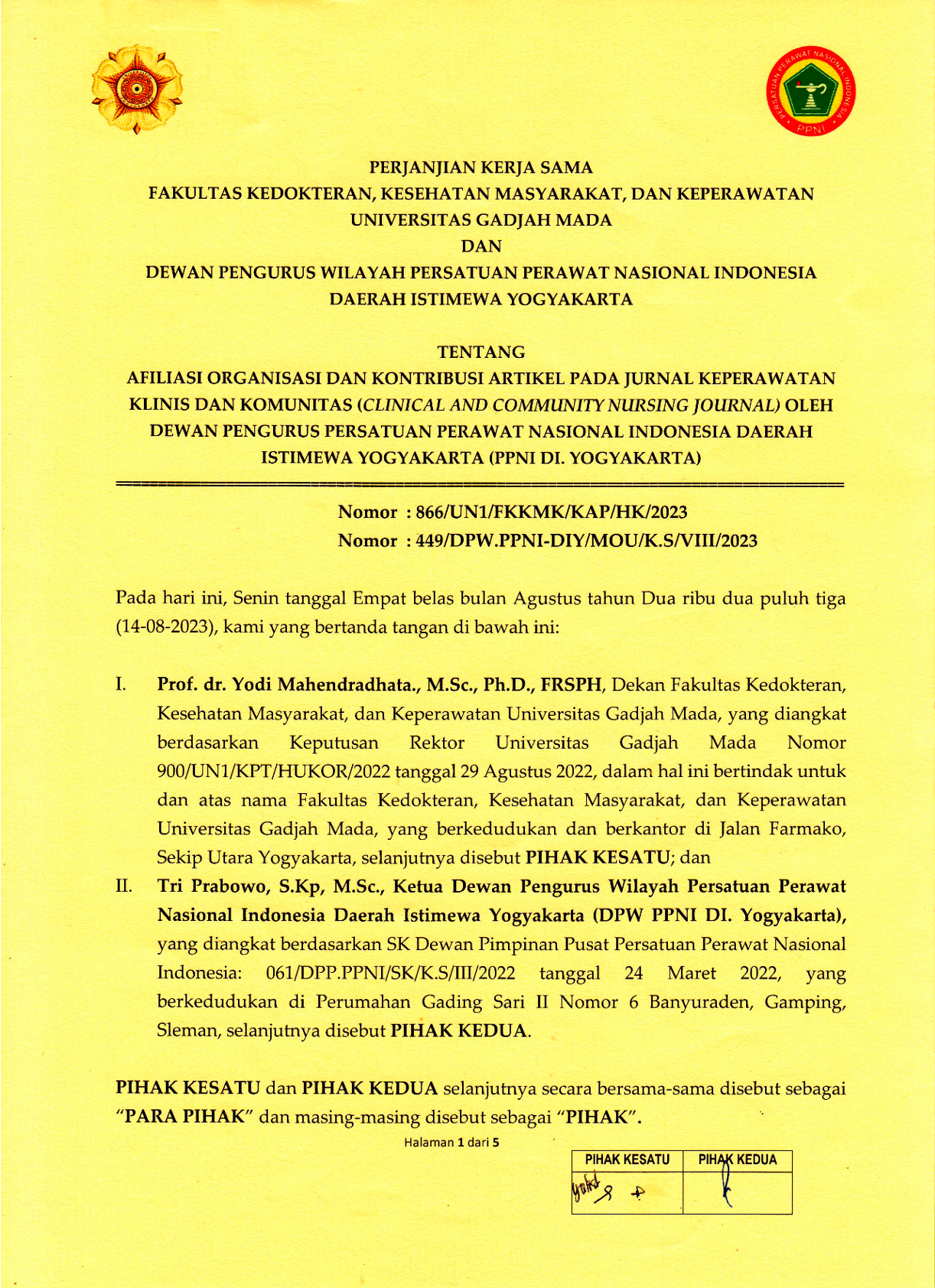Evaluasi Lama Waktu Pelaksanaan Keterampilan Keperawatan pada Objective Structured Clinical Evaluation di Comprehensive Clinical Nursing Skills
Heny Suseani Pangastuti(1*), Sri Setiyarini(2)
(1) Departemen Keperawatan Medikal Bedah, Fakultas Kedokteran, Universitas Gadjah Mada, Yogyakarta
(2) Departemen Keperawatan Dasar dan Emergensi, Fakultas Kedokteran, Universitas Gadjah Mada, Yogyakarta
(*) Corresponding Author
Abstract
Background: “Comprehensive Clinical Nursing Skills (CCNS)" is a compulsory subject for students of School of Nursing Faculty of Medicine Universitas Gadjah Mada who have already finished the academic stage, in order to prepare them to get into the internship stage. In this subject, students learn essential skills and will then be evaluated through Objective Structured Clinical Evaluation (OSCE) method. The length of examination is 7 minutes. However, there has been no previous study to identify whether such duration is adequate for students to perform particular nursing skills.
Objective: To identify the average length of each nursing skill evaluated through OSCE in School of Nursing Faculty of Medicine Universitas Gadjah Mada, Yogyakarta.
Methods: This study was a descriptive study with cross-sectional approach. It was conducted in August 2008 in School of Nursing Faculty of Medicine Universitas Gadjah Mada. The population was all students who undertook OSCE CCNS in August 2008. The samples were 41 respondents by total sampling. Data were collected via observation sheets and stop watch. Data were analyzed using simple statistics to report the mean length of each nursing skill.
Results: The average length of time of 8 nursing skills were shown as follows: average length for health education was 3 minutes 56 seconds (SD ± 58,35 seconds), restrain 6 minutes 4 seconds (SD ± 59,12 seconds), delivery of baby 5 minutes 42 seconds (SD ± 57,78 seconds), CPR 5 minutes (SD ± 58,25 seconds), tracheostomy care 5 minutes 11 seconds (SD ± 1 minute 1,68 seconds), drug injection 5 minutes 22 seconds (SD ± 55,6 seconds), communication 5 minutes 23 seconds (SD ± 1 minute 13,27 seconds) and vital sign examination 5 minutes 42 seconds (SD ± 53,55 seconds). The means of other skills (NGT insertion, wound care, and new born care) could not be analyzed because more than 25% of participants could not finish those skills in 7 minutes, so the results could be bias.
Conclusion: The average length of time of nursing skills implementation in OSCE CCNS was 5 minutes 17 seconds with standard deviation 22,63 seconds.
ABSTRAK
Latar Belakang: "Comprehensif Clinical Nursing Skills (CCNS)” wajib diikuti oleh seluruh mahasiswa yang telah menyelesaikan tahap akademik. Program ini dilakukan untuk mempersiapkan mahasiswa memasuki tahap internship. Pada program ini mahasiswa belajar dan dievaluasi kompetensinya pada keterampilan tertentu seperti komunikasi, pemeriksaan klinis ataupun prosedur klinis melalui metode Objective Structured Clinical Evaluation (OSCE). Lamanya waktu untuk ujian keterampilan yang digunakan di PSIK selama ini adalah 7 menit, walaupun begitu belum pernah dilakukan penelitian untuk menentukan apakah waktu tersebut cukup bagi mahasiswa melakukan suatu keterampilan keperawatan.
Tujuan: Mengetahui rata-rata waktu pelaksanaan masing-masing keterampilan keperawatan yang diujikan pada OSCE-CCNS di Program Studi llmu Keperawatan, Fakultas Kedokteran, Universitas Gadjah Mada, Yogyakarta.
Metode: Penelitian ini merupakan penelitan deskriptif observasional yang dilakukan di PSIK FK UGM pada bulan Agustus 2008. Populasi penelitian adalah seluruh mahasiswa peserta OSCE CCNS periode bulan Agustus 2008, dan sampel diambil dengan cara total sampling dengan 41 peserta Data diperoleh dengan menggunakan instrumen berbentuk lembar observasi dan alat bantu stopwatch. Analisis data dilakukan menggunakan statistik sederhana untuk mengetahui rata-rata lama waktu pelaksanaan keterampilan keperawatan.
Hasil: Hasil penelitian lama waktu pelaksanaan pada delapan keterampilan keperawatan menujukkan hasil rata-rata untuk keterampilan pemberian pendidikan kesehatan 3 menit 56 detik (SD ± 58.35 detik), pemasangan restrain 6 menit 4 detik (SD ± 59,12 detik), menolong persalinan 5 menit 42 detik (SD ± 57,78 detik), RJP 5 menit (SD ± 58,25 detik), perawatan trakeostomi 5 menit 11 detik (SD ± 1 menit 1,68 detik), injeksi obat 5 menit 22 detik (SD ± 55,6 detik, komunikasi 5 menit 23 detik (SD ± 1 menit 13,27 detik) dan pemeriksaan tanda vital 5 menit 42 detik (SD ± 53,55 detik). Tiga keterampilan lainnya, yaitu pemasangan NGT, perawatan luka dan perawatan bayi baru lahir tidak dianalisis karena jumlah mahasiswa yang tidak dapat menyelesaikan keterampilan tersebut lebih dari 25%, sehingga dapat menimbulkan bias.
Kesimpulan: Rata-rata lama waktu pelaksanaan delapan keterampilan keperawatan pada OSCE CCNS PSIK FK UGM adalah 5 menit 17 detik dengan standar deviasi 22,63 detik.
Keywords
Full Text:
PDFReferences
Panduan CCNS PSIK FK UGM.Program Studillmu Keperawatan, Fakultas Kedokteran,Universitas Gadjah Mada,Yogyakarta, 2008.
Kowlowitz V, Hoole AJ, Sloane PD.Implementing the objective structured clinicalexamination in a traditional medical school.Academic Medicine. 1991;66(6):345—7.
Rushforth, HE. Objective structured clinicalexamination (OSCE): Review of literatureand implications for nursing education. NurseEducation Today. 2007;27(lssue 5)July:481-90.
Bujack L, McMillan M, Dwyer J, HazeltonM, Assessing comprehensive nursing The objective structured clinicalassessment (OSCA): part 1 – Developmentof the assessment strategy. Nurse EducationToday.1991a; 11:179-84.
Miller GE. The assessment of clinical skills/competence/performance.Academic Medicine.1990;65(9):S63-7.
Reed S. Canadian competence. Nursing 1992;88(3):57-9.
Wass V, Vleuten CVD, Shatzer J, Jones R.Assessment of clinical competence The 2001;357(March 24).
Nicol M and Freeth D. Assessment of clinicalskills: a new approach to an old problem.Nurse Education Today.1998;18:601-609.
Watson R, Stimpson A, Topping A, Porock D.Clinical competence assessment in nursing: asystematic review of the literature. Journal ofAdvanced Nursing. 2002;39(5):421-31.
Brosnan M, Evans W, Brosnan E, and Brown Implementing objective structured clinicalskills evaluation (OSCE) in nurse registrationprogrammes in a centre in Ireland: A utilizationfocused evaluation. Nurse Education Today. 2006;26(Issue 2)February:115-22.
Alinier G. Nursng students and lecturers’perspectives of cbjective structured clinicalexamination ncorporating simulation. NurseEducation Today.2003; 23:419-26.
Wallace J. Rao R. Haslam R. Simulated patients and objective structured clinical examinations: review of their use in medical Advances in Psychiatric Tratment. 2002;8:342-5.
Van der Vleuten C, Newbie D, eta1. Methods of assessment in certification. In: Newbie D et al (eds) The certification and recertification of doctors. Cambridge University Press, Cambridge, 1994:105-125.
Wass V, Van der Vleuten C, Shatzer J, Jones, Assessment of clinical competence. Diambil dari Proquest, 12 Juni 2009. The Lancet, 2001; 357(March 24):945-9.
Harden R. What is an OSCE? Medical 1988;10:19-22.
Nulty DD, Mitchell ML, Jeffrey CA, Henderson A, Groves M. Best Practice Guidelines for use of OSCEs: Maximizing value for student Nurse Education Today. 2010 doi:10.1016/j.nedt.2010.05.006.
Ward H and Julian Barratt. Passing your advanced nursing OSCE. Radeliffe Publishing UK. 2009.
Ryde A, Sachar AT, Young S, Hukin A, Davies T, Rao R. Organising a mock OSCE for the MRCPsych part I examination. Psychiatric 2005:29:67-70
Amiel G, Tann M, Krausz M, Bitterman A, Cohen R. Increasing examiner involvement in an objective structured clinical examination by integrating a structured oral The American Journal of Surgery, 1997;173:546-9.
Does studying for an objectives tructured clinical examination make a difference? Medical Education. 2000;34:808-12.
Downing S, Haladyna T. Validity threats: overcoming interface with proposed interpretations of assessment data. Medical 2004;38:327-33.
Alinier G, Hunt WB, Gordon R. Nurse education in practice. 2004;4:200-207.
El-Nemer A, Kandeel N. Using OSCE as an assessment tool for clinical skills: nursing students’ feedback. Australian Journal of Basic and Applied Sciences. 2009;3(3):2465-72.
Mitchell ML, Henderson A, Groves M, Dalton M, Nulty D. The objective structured clinical examination (OSCE): Optimizing its value in the undergraduate nursing curriculum. Nurse Education Today.2009;29:398-404.
Monaghan M, Turner P, Vanderbus R, and Grady A. Traditional studentt, non-traditional student, and pharmacy practioner attitudes towards the us e of standardized patients in the assessment of clinical skills. American Journal of Pharmaceutical 2000;64:27-32.
Article Metrics
Refbacks
- There are currently no refbacks.
Copyright (c) 2017 Heny Suseani Pangastuti, Sri Setiyarini

Jurnal Keperawatan Klinis dan Komunitas (Clinical and Community Nursing Journal)
collaborates with DPW PPNI DIY
![]()
Jurnal Keperawatan Klinis dan Komunitas (Clinical and Community Nursing Journal) is licensed under a Creative Commons Attribution-ShareAlike 4.0 International License.




